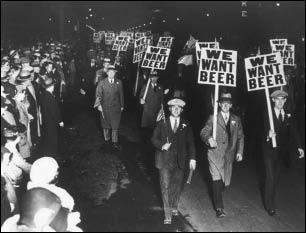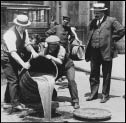Prohibition
All across North America temperance movements, groups that believed drinking alcohol was a social evil and a sin, gained strength and support. Prince Edward Island prohibited the sale or consumption of alcohol in 1901. In 1907 Mississippi followed. But it was the Great War that gave the movement national impetus in the United States and Canada.
In 1919 Congress passed the Eighteenth Amendment to the Constitution, prohibiting the manufacture, sale, or transportation of any beverage with an alcohol content greater than 0.5 percent. This immediately destroyed the liquor, beer, and wine manufacturing industries and created a black market, mostly run by gangsters such as Al Capone.

Labour union members marching through Newark, New Jersey, in 1931, protesting prohibition.
Library of Congress, LC-USZ62-123216.

Men pouring out liquor during prohibition.
Since Canada did not enact a national prohibition law, it suddenly became very profitable to take beer and liquor south to sell. Bootleggers thrived in eastern Canada, where they could supply the tens of thousands of illegal drinking establishments (speakeasies) in Chicago and the other major cities, but smuggling went on all along the vast undefended border. On the west coast there was a running battle, among the inlets and beaches of the Gulf Islands and the Washington coast, between revenue agents and rum-runners.
As the war between gangsters to control the bootleg industry spilled onto the streets, public opinion turned against prohibition. Incidents like the murder of seven men on St. Valentine’s Day 1929 shocked people and, combined with the effects of Great Depression, led to the repeal of prohibition in 1933.